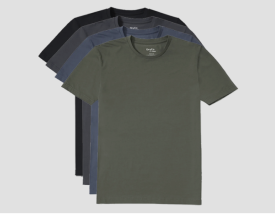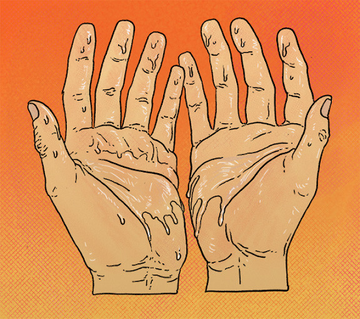This time of year we put time aside to reflect on ourselves what we can do to improve our health, happiness, and lifestyle. This year, we’re taking a look at a few common New Year’s resolutions and how we can apply them to stopping hyperhidrosis triggers.
5. Diet
You can’t spell sweat without e-a-t. The foods you eat have a direct impact on controlling your hormones, glands, and bodily fluids. Picking the right foods can make all the difference in how much you sweat.
Foods to Avoid
In the cold of winter, spicy foods can be a nice comfort. Capsaicin, a natural chemical in pepper, is the cause of this comforting warmth. It signals nerves that make your body feel warm. This same effect, however, can also make you sweat. Tricking your body into feeling warm, makes it sweat in an attempt to cool down.
Many of us like to kick off the day with a coffee. But caffeine doesn’t just jump start your day, it also gets your sweat glands going. Caffeine stimulates the nervous system in a similar way to stress, anger, or fear. As a result, the body starts to sweat. Try to avoid, or minimize caffeine.
Ringing in the new year always seems to coincide with alcohol. But if ever there was a year to change things up, this is it.
Alcohol affects almost all parts of your body, from your central nervous system to your inhibitions. So it’s no surprise it also affects your sweat. Consumption, especially overconsumption, of alcohol widens blood vessels and increases heart rate. As a result, you start to sweat.
Like all of these foods to avoid, it’s okay to enjoy them from time to time. But enjoying them too much or too often will mean a sweaty 2021.
Foods to Eat
The foods you eat can also have a positive effect on sweating. Dairy, for instance, helps to break down sweat resulting in less perspiration as well as less odor from perspiration. Milk and yogurts are great sources of sweat-fighting dairy.
Seemingly counterintuitively, hydration is also important for fighting sweat. And if you’re already sweating a lot, it’s important for replacing the lost fluids your body needs. In addition to drinking lots of water, healthy foods like watermelon and cucumber are a delicious way of hydrating.
The right nutrients are also important for combatting sweat. B Vitamins help to regulate hormones, minimize stress, and help you stop anxious or nervous sweating. Salmon, beef, and eggs are great sources of natural B Vitamins.
If sweat is a problem, it’s important to replenish your magnesium. Dark leafy greens are a good source of this nutrient. Getting enough magnesium is important for healthy sleep, lowering blood pressure, and reducing diabetes risks.
4. Mind and Body
If stress and anxiety are your hyperhidrosis triggers, the best change may come from within. Relaxation techniques like meditation can calm your mind and body. As a result, they reduce both stress and anxiety, preventing them from signaling hormones that cause sweat.
Meditative techniques are available free through apps and YouTube videos, and become more effective with practice. If meditation isn’t really your speed, other mindful practices like yoga and breathing exercises can also help you relax.
3. Weight Loss & Exercise
If you want to stop perspiring, your best bet may be to sweat a little more. Working out for fitness and weight loss can have a huge impact on hyperhidrosis management. Carrying around excess fat increases overall sweating in both frequency and volume.
Fat loss isn’t the only way that exercise reduces sweating. Studies have shown that while people who exercise regularly start sweating earlier during exercise, they sweat less during regular activity. Starting a fitness routine sets a new bar for what it takes for your body to start sweating. As a result, you sweat less throughout the day.
2. Start a Hyperhidrosis Diary
Just like logging your diet and activity are a great way to maximize your fitness goals, creating a sweat diary can help identify and stop hyperhidrosis triggers. Most of us have some idea of what makes us sweat, like nerves or spicy foods. But few know the full extent of their triggers or the effectiveness of their anti-sweat efforts.
Use your hyperhidrosis diary to track your sweat every day. Consider using a rating system based on severity, similar to the HDSS scale. For example, rate a day with low or minimal sweat as a “one” and a severe perspiration day as a “four.” Exclude perspiration from exercise from this rating.
Next, track what you ate that day. As well as your mental state (low stress, medium stress, high stress), and any efforts you made to prevent sweat such as meditation or medication.
The goal is to find patterns that identify specific hyperhidrosis triggers as well as effective treatments. For instance, you may recognize that certain foods always seem to coincide with severe perspiration days. Or that on days where you wear breathable, sweat-wicking undershirts you have less perspiration.
The longer you keep a hyperhidrosis diary and the more detail you include in your notes, the greater the ability to identify triggers. As well, you can more accurately track the efficacy of your hyperhidrosis management efforts.
1. Fashion
It’s hard to look your best while fighting sweat. Even Gucci loses some of its effect while sporting pit stains. But when it comes to sweat-resistant clothing, you have options! You don’t have to choose between being dry and fashionable.
Recent advances in clothes for hyperhidrosis management are changing the game for everyone. Whether you sweat a little, or a lot, these keep you comfortable, dry, and confident. Breathable, lightweight, moisture-wicking materials have a three-pronged effect.
- Reduce Sweating Overall
- Reduce/Prevent Body Odor
- Remove Sweat Before it Pools
Of course, not all your clothing needs to be made of the same sweat-resistant materials. Choosing the right sweatproof undershirt can keep just about any outfit dry and looking great.
At Neat Apparel, we use advanced anti-sweat fabric technology to combat even tough sweat in comfort and style. Sweatproof polos, undershirts, and t-shirts that can fit any wardrobe any time of year.








